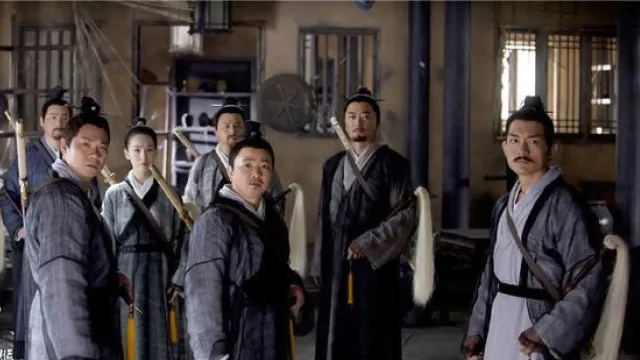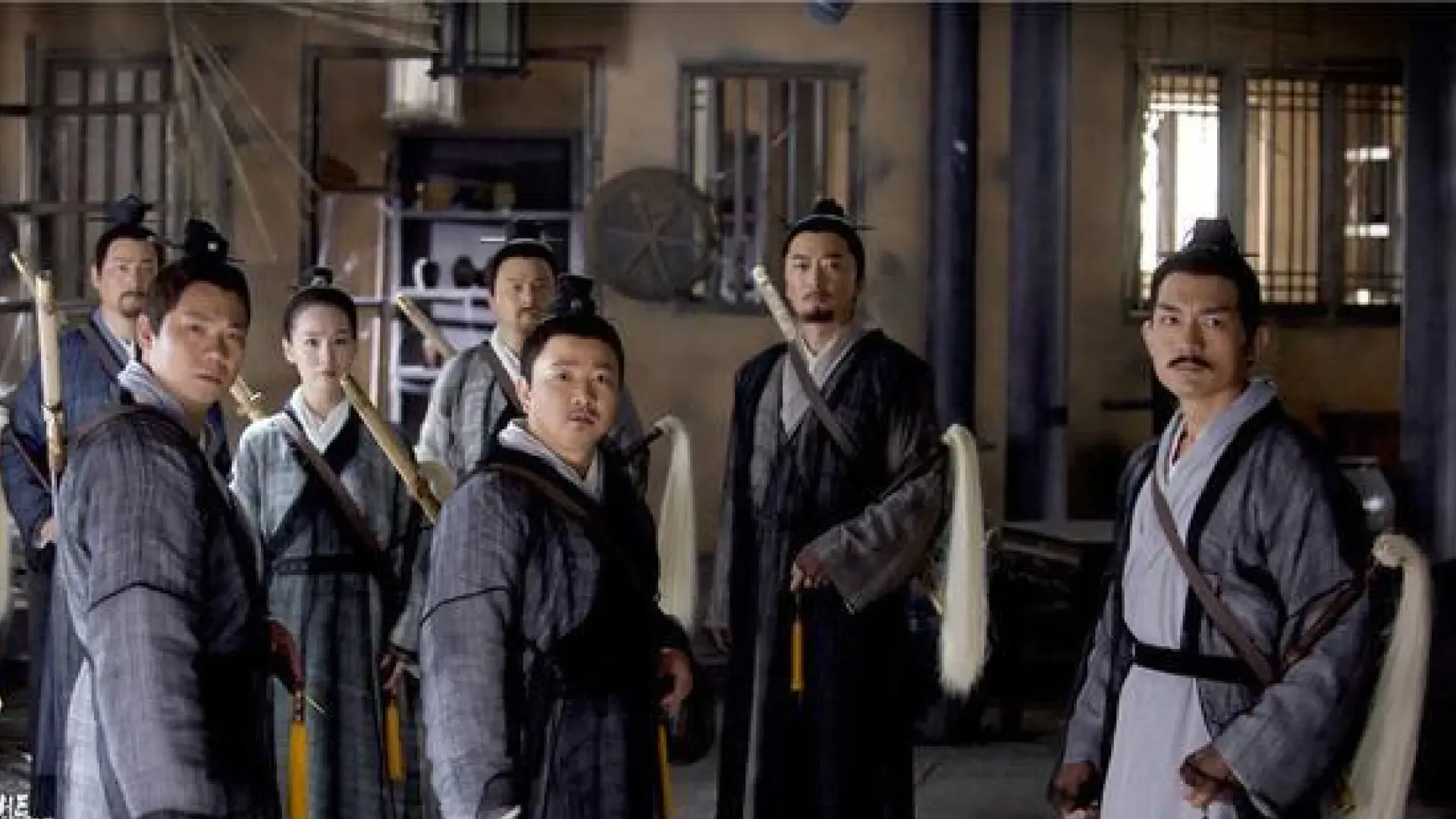Tan Chuduan (simplified: 谭处端, traditional: 譚處端, pinyin: Tán Chǔduān, jyutping: taam4 cyu5 dyun1), known by his Daoist name Changzhenzi (长真子, Chángzhēnzǐ), was one of the Seven Zis of Quanzhen and the second leader of the Quanzhen Order after Ma Yu. A disciple of Wang Chongyang, the Central Divine of the Five Greats, Tan Chuduan was renowned for his theological depth and administrative skills. He founded the Namo School, a sub-school within the Quanzhen Order that integrated Buddhist mantras with Daoist cultivation practices, reflecting the Order’s syncretic philosophy.1
His leadership tenure, though brief, helped maintain the Quanzhen Order’s spiritual integrity during a period of rapid growth and expansion throughout the jianghu. His tragic death at the hands of Ouyang Feng during the confrontation at Misty Rain Pavilion marked a significant loss for the Order and demonstrated the deadly consequences of the ongoing conflicts between the orthodox and heterodox martial arts factions.
Biography
Early life and discipleship
Tan Chuduan entered the Quanzhen Order during Wang Chongyang’s early recruitment of disciples in Shandong Province. Like his martial brothers and sister, he was selected for his exceptional potential in both martial arts and spiritual cultivation. Under Wang Chongyang’s tutelage, he mastered the fundamental Innate Skill and various Quanzhen martial arts techniques.
His Daoist name “Changzhenzi” (长真子), meaning “Long Truth Master,” reflected his deep commitment to seeking authentic spiritual truth through Daoist practices. Among the Seven Zis, Tan was particularly noted for his scholarly approach to Daoist theology and his ability to synthesize different religious traditions into coherent practice methods.
Formation of the Namo School
One of Tan Chuduan’s most significant contributions to the Quanzhen Order was his establishment of the Namo School (also known as Namo Daoism), a sub-school that represented his innovative approach to spiritual cultivation. The Namo School integrated Buddhist mantras and chanting practices with traditional Daoist qi cultivation, creating a unique synthesis that appealed to practitioners seeking multiple paths to enlightenment.
This theological innovation reflected Tan’s broad understanding of Chinese religious traditions and his pragmatic approach to spiritual development. The Namo School’s emphasis on combining vocal cultivation (through mantras) with silent meditation represented a balanced approach that accommodated different personality types and spiritual inclinations within the Order.
The founding of the Namo School also demonstrated the Quanzhen Order’s flexibility and willingness to incorporate useful elements from other traditions, a characteristic that contributed to its widespread appeal and rapid growth throughout the martial arts world.
Leadership of the Quanzhen Order
Following Ma Yu’s tenure as the first leader after Wang Chongyang’s death, Tan Chuduan assumed leadership of the Quanzhen Order in 1183. His leadership style emphasized scholarly administration and theological development, contrasting with Ma Yu’s more diplomatic approach and the later militant activism of Qiu Chuji.
During his brief two-year leadership (1183-1185), Tan focused on consolidating the Order’s spiritual foundations and ensuring that rapid expansion did not compromise the quality of martial and religious instruction. He worked to standardize training methods across different Quanzhen branches and to maintain the high standards that Wang Chongyang had established.
His administrative approach proved effective in maintaining organisational unity during a period when the Order was establishing sub-sects and expanding into new territories. The theological depth he brought to leadership helped preserve the authentic Daoist character of the Order while allowing for necessary adaptations to local conditions and student needs.
The crisis at Misty Rain Pavilion
Tan Chuduan’s leadership and life came to a tragic end during the confrontation at Misty Rain Pavilion in Jiaxing. The conflict began when the Quanzhen Masters, using their Big Dipper Formation, engaged in combat with Huang Yaoshi, the Eastern Heretic of the Five Greats, and his disciple Mei Chaofeng.
The battle represented one of the most significant confrontations between orthodox and heterodox martial arts practitioners of the era. The Seven Zis’ formation demonstrated their collective martial prowess, but the intervention of Ouyang Feng, the Western Venom, transformed the situation from a challenging but manageable conflict into a deadly catastrophe.
Death and martyrdom
During the height of the battle at Misty Rain Pavilion, Ouyang Feng launched a surprise attack that caught the Quanzhen Masters off guard. His intervention was both strategically devastating and personally tragic, as he specifically targeted Tan Chuduan with a lethal strike that killed the Quanzhen leader instantly.
Tan’s death represented more than just the loss of a skilled martial artist; it marked the end of a scholarly and spiritually-focused leadership approach within the Quanzhen Order. His martyrdom during the defense of orthodox martial arts principles elevated him to legendary status within the Order and the broader jianghu community.
The impact of his death reverberated throughout the Quanzhen Order, leading to significant changes in leadership philosophy and martial strategy. His successor, Liu Chuxuan, would serve only briefly before transferring leadership to the more militantly-inclined Qiu Chuji, marking a shift toward more aggressive engagement with jianghu conflicts.
Personality and traits
Scholarly temperament
Tan Chuduan possessed a deeply scholarly and contemplative nature that distinguished him from some of his more action-oriented martial brothers. His approach to both martial arts and spiritual cultivation emphasized understanding the theoretical foundations before practical application, making him an excellent teacher and administrator.
His theological interests extended beyond pure Daoist doctrine to include Buddhist philosophy and Confucian ethics, reflecting a synthesizing mind that sought common truths across different traditions. This intellectual breadth contributed to his success in founding the Namo Sect and in maintaining organisational unity during his leadership tenure.
Administrative wisdom
Unlike the diplomatic Ma Yu or the militant Qiu Chuji, Tan Chuduan brought systematic administrative skills to Quanzhen leadership. His approach emphasized establishing clear protocols, standardized training methods, and consistent quality control across the Order’s various branches and sub-sects.
His administrative philosophy balanced respect for traditional methods with practical adaptations necessary for organisational growth. This combination of conservatism and flexibility proved essential during the Order’s period of rapid expansion following Wang Chongyang’s death.
Spiritual depth
Tan’s commitment to authentic spiritual development went beyond mere martial arts achievement to encompass genuine religious enlightenment. His integration of Buddhist and Daoist practices reflected a sincere belief that spiritual truth transcended sectarian boundaries and that effective cultivation could draw from multiple sources.
This spiritual depth influenced his approach to leadership, making him more concerned with the long-term character development of disciples than with immediate martial arts advancement or political influence. His emphasis on spiritual integrity over worldly success distinguished his leadership style from those of his successors.
Martial arts abilities
Quanzhen foundational arts
As one of Wang Chongyang’s direct disciples, Tan Chuduan mastered the profound Innate Skill that formed the foundation of all Quanzhen martial arts. His qi cultivation reached exceptional levels, though his scholarly temperament led him to emphasize the theoretical and spiritual aspects of the art rather than purely martial applications.
The Innate Skill provided Tan with remarkable longevity and spiritual clarity, supporting both his martial techniques and his administrative duties. His mastery of qi cultivation made him particularly effective in group formations where individual skills could be harmonized with those of his martial siblings.
Big Dipper Formation mastery
As one of the Seven Zis, Tan participated in the legendary Big Dipper Formation, occupying the position corresponding to the star Tianxuan (天璇). Within this formation, his role involved providing stable foundational support that allowed his more aggressive martial brothers to take offensive positions.
His performance in the formation emphasized precision and timing rather than raw power, reflecting his scholarly approach to martial arts. The formation’s effectiveness derived partly from Tan’s ability to maintain consistent energy flow and positioning even under extreme pressure, providing the stability necessary for collective defense.
During the tragic battle at Misty Rain Pavilion, the formation demonstrated its legendary effectiveness against formidable opponents before Ouyang Feng’s surprise intervention disrupted its integrity and led to Tan’s death.
Namo School techniques
Tan’s founding of the Namo School involved developing specialized cultivation techniques that combined Daoist internal energy work with Buddhist vocal practices. These methods included various forms of mantra chanting coordinated with breathing exercises and energy circulation patterns.
The Namo School techniques proved particularly effective for practitioners who benefited from vocal cultivation methods, providing alternative approaches to traditional silent meditation. The integration of sound and energy work created unique healing and spiritual development applications that enhanced the overall repertoire of Quanzhen martial arts.
Theoretical knowledge
Beyond practical martial skills, Tan possessed extensive theoretical knowledge of Chinese martial arts principles, making him an exceptional teacher and strategic advisor. His understanding of energy flow, anatomical pressure points, and combat psychology provided valuable insights for developing training methods and tactical approaches.
This theoretical expertise proved particularly valuable during his leadership tenure, as he could provide guidance on complex martial arts problems that required understanding of underlying principles rather than simple technical application.
Relationships
Wang Chongyang
Tan’s relationship with his shifu2 Wang Chongyang was characterized by deep intellectual connection and shared interest in religious philosophy. Wang recognized Tan’s scholarly gifts and encouraged his development of the Namo School as a legitimate expression of Quanzhen principles.
Under Wang’s guidance, Tan developed both his martial abilities and his understanding of religious synthesis, becoming one of the most theologically sophisticated members of the Seven Zis. This relationship provided the foundation for his later leadership approach and his contributions to Quanzhen doctrine.
The Seven Zis
Among his martial siblings, Tan maintained relationships characterized by mutual respect and complementary abilities. His scholarly approach balanced the diplomatic skills of Ma Yu, the aggressive tendencies of Qiu Chuji, and the various specializations of Wang Chuyi, Liu Chuxuan, Hao Datong, and Sun Bu’er.
His interactions with Liu Chuxuan were particularly close, as both shared scholarly interests and administrative concerns. This relationship would prove crucial when Liu succeeded Tan as leader, ensuring continuity in the Order’s administrative systems despite the tragic circumstances of the transition.
Institutional legacy
Tan’s founding of the Namo School created lasting relationships between the main Quanzhen Order and its sub-schools, establishing patterns of cooperation and mutual support that would influence the organisation for generations. His administrative innovations provided frameworks that subsequent leaders could adapt to changing circumstances.
The respect he earned from disciples and fellow masters created a foundation of institutional loyalty that helped the Order survive the crisis following his death and continue its expansion under subsequent leadership.
Behind the scenes
Legacy and influence
Theological contributions
Tan Chuduan’s integration of Buddhist and Daoist practices through the Namo School provided a model for religious synthesis that influenced Chinese martial arts development for centuries. His demonstration that authentic spiritual cultivation could draw from multiple traditions while maintaining doctrinal integrity became a significant contribution to Chinese religious thought.
The Namo School’s survival and continued influence within the Quanzhen Order testified to the practical value of Tan’s theological innovations and their relevance to practitioners seeking comprehensive spiritual development.
Administrative systems
The organisational methods Tan developed during his leadership tenure established precedents for managing large, geographically dispersed martial arts organisations. His emphasis on standardized training protocols and quality control became influential throughout the jianghu as other organisations sought to emulate Quanzhen’s success.
His approach to balancing central authority with local adaptation provided a model for organisational flexibility that proved essential for long-term institutional survival in the changing political landscape of medieval China.
Educational philosophy
Tan’s scholarly approach to martial arts education emphasized understanding principles before practicing techniques, influencing teaching methods throughout the orthodox martial arts community. His integration of theoretical knowledge with practical application became a hallmark of high-quality martial arts instruction.
The respect he earned as both warrior and scholar demonstrated the possibility of combining intellectual depth with martial prowess, inspiring generations of practitioners to pursue comprehensive development rather than narrow specialization.
Tan Chuduan represents Jin Yong’s exploration of the scholarly-warrior ideal in Chinese culture, embodying the traditional Confucian concept that true excellence requires both martial prowess and intellectual cultivation. His character demonstrates how spiritual depth and administrative wisdom can contribute to martial arts organisations beyond mere fighting ability.
The historical Tan Chuduan (1123-1185) was indeed one of the Seven Masters of Quanzhen and the third leader of the Quanzhen Order, providing Jin Yong with authentic historical foundation for the character. The historical figure’s reputation for theological innovation and his founding of the Namo tradition influenced Jin Yong’s portrayal of the character’s spiritual contributions.
His tragic death in the novel serves multiple narrative functions, demonstrating the real costs of jianghu conflicts while providing motivation for the surviving Quanzhen Masters to pursue more aggressive policies under subsequent leadership. The loss of his scholarly perspective represents the broader theme of how violence can destroy cultural and spiritual achievements.
Portrayals
Tan Chuduan has appeared in various television and film adaptations of Jin Yong’s novels, though his role is typically smaller than those of more prominent characters like Ma Yu or Qiu Chuji:
The Legend of the Condor Heroes
- 1983 series – Yeung Chak-lam
- 1994 series – Hui Shiu-hung
- 2003 series – Zhang Guoqiang
- 2008 series – Jin Dong
- 2017 series – Wang Zhihua
Most portrayals emphasize his scholarly demeanor and spiritual authority among the Seven Zis, often depicting him as a wise and thoughtful leader whose death represents a significant loss for the orthodox martial arts community.
See also
- The Legend of the Condor Heroes characters
- The Return of the Condor Heroes characters
- Wang Chongyang – His master
- Seven Zis of Quanzhen – His faction
- Quanzhen Order – His sect
- Ma Yu – His martial brother and successor
- Qiu Chuji – His martial brother
- Liu Chuxuan – His martial brother and close friend
- Namo School – The sub-school he founded
External links
- Tan Chuduan on Wikipedia
- Tan Chuduan (Chinese) on Chinese Wikipedia (historical figure)
- Tan Chuduan (Chinese) on Baidu Baike
Footnotes
-
江湖 – jiānghú. The world of martial arts. A sub-society involving all who are related to the martial arts scene. What is jianghu? ↩
-
师父 – shīfū. Teacher or master responsible for technical instruction and moral guidance. Shī means teacher. Fū means father. See Wuxia Wiki. ↩


